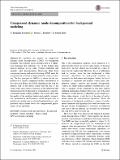Files in this item
Compressed dynamic mode decomposition for background modeling
Item metadata
| dc.contributor.author | Erichson, N. Benjamin | |
| dc.contributor.author | Brunton, Steven L. | |
| dc.contributor.author | Kutz, J. Nathan | |
| dc.date.accessioned | 2016-12-16T16:30:11Z | |
| dc.date.available | 2016-12-16T16:30:11Z | |
| dc.date.issued | 2016-11-29 | |
| dc.identifier.citation | Erichson , N B , Brunton , S L & Kutz , J N 2016 , ' Compressed dynamic mode decomposition for background modeling ' , Journal of Real-Time Image Processing , vol. First Online . https://doi.org/10.1007/s11554-016-0655-2 | en |
| dc.identifier.issn | 1861-8219 | |
| dc.identifier.other | PURE: 248203435 | |
| dc.identifier.other | PURE UUID: 9818e55a-1530-4593-ba2a-a9508ad0436a | |
| dc.identifier.other | RIS: Erichson2016 | |
| dc.identifier.other | Scopus: 85000350946 | |
| dc.identifier.other | WOS: 000489318600010 | |
| dc.identifier.uri | https://hdl.handle.net/10023/9981 | |
| dc.description | JNK acknowledges support from Air Force Office of Scientific Research (FA9500-15-C-0039). SLB acknowledges support from the Department of Energy under award DE-EE0006785. NBE acknowledges support from the UK Engineering and Physical Sciences Research Council (EP/L505079/1). | en |
| dc.description.abstract | We introduce the method of compressed dynamic mode decomposition (cDMD) for background modeling. The dynamic mode decomposition is a regression technique that integrates two of the leading data analysis methods in use today: Fourier transforms and singular value decomposition. Borrowing ideas from compressed sensing and matrix sketching, cDMD eases the computational workload of high-resolution video processing. The key principal of cDMD is to obtain the decomposition on a (small) compressed matrix representation of the video feed. Hence, the cDMD algorithm scales with the intrinsic rank of the matrix, rather than the size of the actual video (data) matrix. Selection of the optimal modes characterizing the background is formulated as a sparsity-constrained sparse coding problem. Our results show that the quality of the resulting background model is competitive, quantified by the F-measure, recall and precision. A graphics processing unit accelerated implementation is also presented which further boosts the computational performance of the algorithm. | |
| dc.format.extent | 14 | |
| dc.language.iso | eng | |
| dc.relation.ispartof | Journal of Real-Time Image Processing | en |
| dc.rights | © The Author(s) 2016. Open Access. This article is distributed under the terms of the Creative Commons Attribution 4.0 International License (http://creativecommons.org/licenses/by/4.0/), which permits unrestricted use, distribution, and reproduction in any medium, provided you give appropriate credit to the original author(s) and the source, provide a link to the Creative Commons license, and indicate if changes were made. | en |
| dc.subject | Dynamic Mode Decomposition | en |
| dc.subject | Background modeling | en |
| dc.subject | Matrix sketching | en |
| dc.subject | Sparse coding | en |
| dc.subject | GPU-accelerated computing | en |
| dc.subject | QA Mathematics | en |
| dc.subject | 3rd-NDAS | en |
| dc.subject.lcc | QA | en |
| dc.title | Compressed dynamic mode decomposition for background modeling | en |
| dc.type | Journal article | en |
| dc.description.version | Publisher PDF | en |
| dc.contributor.institution | University of St Andrews. School of Mathematics and Statistics | en |
| dc.identifier.doi | https://doi.org/10.1007/s11554-016-0655-2 | |
| dc.description.status | Peer reviewed | en |
This item appears in the following Collection(s)
Items in the St Andrews Research Repository are protected by copyright, with all rights reserved, unless otherwise indicated.

